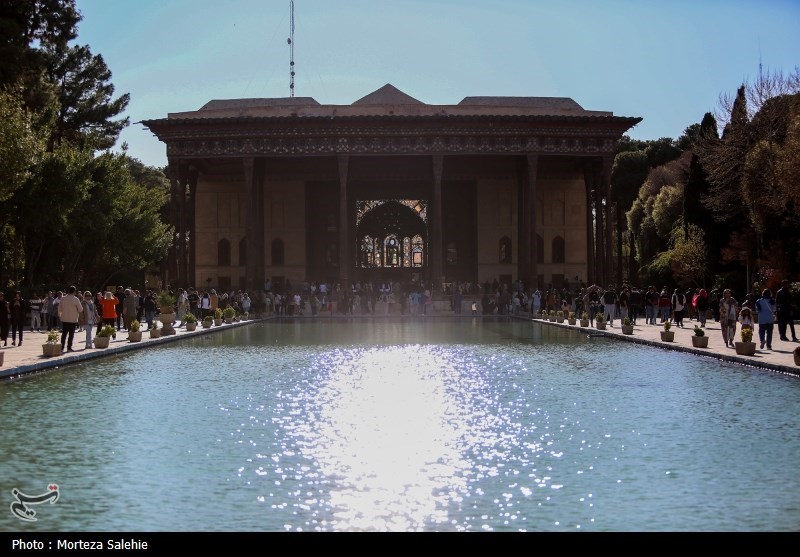Discover the Enchantment of Chehel Sotoun Palace: A Must-See Gem in Isfahan, Iran
The Chehel Sotoun Palace, a remarkable historical site in Isfahan, Iran, stands as a testament to the grandeur of the Safavid Empire. Built in the 11th century AH, this magnificent palace is nestled within expansive gardens and a complex of stunning buildings. It served as a welcoming venue for visitors and foreign ambassadors, showcasing the rich cultural heritage of Iran.
Constructed in three distinct phases, the palace features a main hall, a mirror hall, and adjacent rooms, all interconnected by a grand porch supported by 18 impressive columns topped with a wooden roof. The name “Chehel Sotoun,” which translates to “Forty Columns,” stems from the palace’s numerous pillars and the mesmerizing reflection of twenty of them in the tranquil waters of the surrounding pool.
Architectural Marvels of Chehel Sotoun Palace
The architectural design of the Chehel Sotoun Palace is not only visually stunning but also historically significant. Here are some key features that make this palace a remarkable destination:
- Grand Design: The palace’s layout was meticulously planned to enhance both its aesthetic appeal and functionality.
- Mirror Hall: The mirror hall is a highlight, adorned with intricate mirror work that reflects the light beautifully, creating an enchanting atmosphere.
- Columns and Reflections: The 18 columns are not just structural elements; they are integral to the palace’s identity, symbolizing strength and beauty.
Artistic Heritage
The walls of the Chehel Sotoun Palace are adorned with stunning paintings created by some of the most renowned Persian artists. Notably, a significant contribution came from Reza Abbasi, a distinguished artist of the Safavid period known for his exquisite Persian miniature paintings. His works within the palace include:
- Battlefield Scenes: Four large paintings in the main chamber vividly depict the grandeur of battlefields, showcasing the valor of Safavid kings.
- Formal Gatherings: The same chamber features paintings that illustrate formal gatherings, emphasizing the cultural significance of these events in Safavid society.
- Sadeq Naqqash Bashi: Another prominent artist of the Qajar dynasty, Naqqash Bashi contributed two additional paintings with similar themes, enriching the palace’s artistic collection.
Unfortunately, the palace has endured its share of devastation. A number of the original paintings were lost during the tumultuous reign of Zell-ul-Soltan, which significantly impacted the palace’s artistic legacy. Despite this, some remarkable pieces of poetry remain, inscribed on the columned porch by the talented Mohammad Saleh Isfahani, further enhancing the cultural depth of this site.
Historical Resilience
The Chehel Sotoun Palace has a storied history of resilience and rebirth. In the early 12th century, the building faced destruction by fire, which could have marked the end of its legacy. However, during the reign of Shah Soltan Hossein Safavi, the palace was meticulously reconstructed, allowing it to continue its role as a symbol of the Safavid Empire.
Visiting Chehel Sotoun Palace
Today, the Chehel Sotoun Palace is a must-visit destination for both domestic and international tourists. It offers a glimpse into the opulent lifestyle of the Safavid kings, as well as the artistic and architectural achievements of the period. Visitors can enjoy:
- Guided Tours: Knowledgeable guides provide insights into the rich history and architectural details of the palace.
- Stunning Gardens: The surrounding gardens, with their meticulously landscaped pathways, offer a serene escape.
- Art Exhibitions: Various exhibitions highlight the artistic contributions of Persian artists throughout history.
As you explore the halls and admire the artistry of the Chehel Sotoun Palace, you will find yourself transported back to a time of grandeur and cultural richness. This iconic site not only showcases the architectural brilliance of the Safavid era but also serves as a reminder of the enduring legacy of Persian art and culture.
In conclusion, the Chehel Sotoun Palace is more than just a historical site; it is a vibrant symbol of Iran’s rich heritage. Its architectural beauty, artistic treasures, and historical significance make it an essential destination for anyone seeking to understand the profound legacy of the Safavid Empire.






